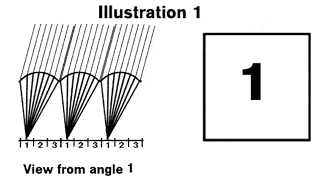



 |
|
| How it works! |
|
|
|
|
|
How it works!
Lenticular graphics can be described as specialized images which when viewed under certain circumstances will produce 3-D or animated sequences. The technology of this product consists of two main elements-a specially prepared(interlaced)image that contains data from two or more graphics which is placed in precise alignment with a lenticular lens. The lenticular lens isolates, magnifies, and displays the image data from each individual graphic according to the angle of observation(Ill.1).Bearing these points in mind, we can begin to understand how the 3-D and animated effects are achieved. 
Perception of depth in humans is due to the fact that we have two eyes offset from each other which view our environment from two slightly different perspectives. Our brains subconsciously converge these two views such that the differences in the spatial relationships of the objects viewed give us the perception of depth. There are several stereoscopic technologies that give the effect of depth, however, most suffer from the limitation of requiring special glasses to isolate the left and right eye perspective views. Lenticular graphics have the benefit of not requiring specialized glasses to perceive depth. Referring back to the first paragraph, a lenticular lens isolates, magnifies, and displays a single graphic image according to the angle of observation .If the lenticular lens is oriented perpendicular to the axis of the eyes(i.e.lenticules running vertically or from top to bottom)each eye will view the lenticular lens from slightly different angles. If the multiple graphics interlaced to create the lenticular image are perspective views of an object or scene, they can be arranged such that the left and right perspectives are displayed to their respective eyes giving the viewer the illusion of depth without the need for special glasses. Upon understanding the concepts involved in lenticular 3-D, understanding flip, morph, and full motion lenticular animation is a simple matter. If the lenticular lens is rotated so that the lenticules are oriented parallel to the axis of the eyes(i.e. running horizontally or from left to right) both eyes view the lenticular lens from the same angle of observation. Simply, a single graphic is viewed by both eyes. If the lenticular image is tilted in an up/down direction, the angle of observation changes and the interlaced graphics can be viewed in sequence. It is advisable that lenticular animations, especially handheld images, be oriented in this manner so as to avoid the left and right eyes viewing separate graphic elements. This will minimize observing a latent secondary image commonly referred to as "ghosting". Copyright (C) 2003 Digillax Systems. All rights reserved. | ||


 |
Last update Friday, November 26, 2010 05:20:35 AM